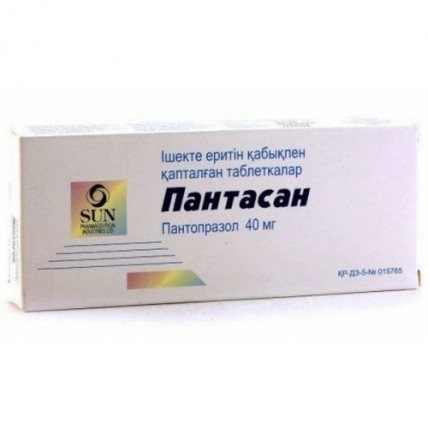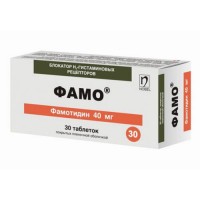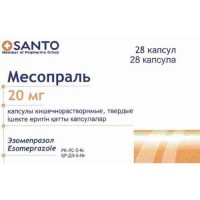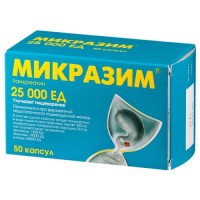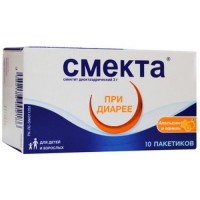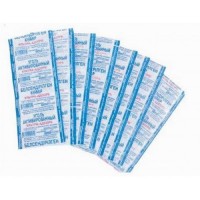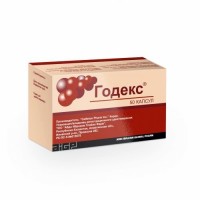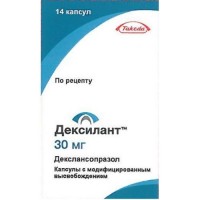Pantasan 40 mg (30 tablets)
- $24.10
The instruction for use
medicine for experts
PANGTASANG of a tablet
of the Tablet of a pantoprazol of sodium (Pantoprazole Sodium).
PANGTASANG
Ingredients:
Each tablet covered with an enteric cover contains
Pantoprazole Sodium Sesquihydrate equivalent 20 or 40 mg of Pantoprazole
Excipients: magnesium oxide, calcium a carbonate, krospovidon, sodium lauryl sulfate, kopovidon, the talc purified calcium stearate, silicon dioxide colloidal, copolymer of methacrylic acid
the Cover type C: triethyl citrate, titan dioxide (E 171), ferrous oxide yellow, polyethyleneglycol 6000
Clinical pharmacology:
Pantoprazol is an inhibitor of a proton pomp, reduces the level of basal and stimulated secretion of hydrochloric acid in a stomach.
Action mechanism:
Pantoprazol is the replaced benzimidazole (benzimidazole) which collects in the acid environment of cell walls after absorption. Here it will be transformed to an active form, namely, to cyclic sulphenamide (cyclic sulphenamide) which connects ATPase H+/K+. Thus, the suction of protons slows down and long-term suppression of acid secretion of a stomach is reached. Because pantoprazol operates on peripheral level, namely at the level of receptors, it can suppress acid secretion of a stomach regardless of the irritant nature (acetylcholine, a histamine, gastrin). Pantoprazol has full effect only in the acid environment (rn
Pharmacokinetics:
Pantoprazol is quickly soaked up. On average the maximum concentration in plasma (about 2-3 micrograms on a milliliter) is reached in 2.5 hours after reception and these values remain constants after numerous drug intakes. Time during which level decreases twice, about 1 hour. The volume of absorption is about 0.15 L/kg and clarification about 0.1 L/kg/h. The pharmacokinetics does not change at single and at multiple drug intake. The kinetics of a pantoprazol in plasma is linear both after oral, and after intravenous reception. Absolute biological activity of a tablet about 77%. Joint reception with food or antiacid means do not influence comprehensibility of medicine, a concentration maximum in plasma and, therefore, biological availability. Linking with proteins of plasma of pantoprazoly about 98%. It is metabolized in a liver. The main metabolite both in plasma, and in urine is dismetilpantoprazol (desmethylpantoprazole) which connects to sulfate. The half-life period of the main metabolites (1.5 hours) not too strongly differs from a half-life period of a pantoprazol. The pharmacokinetics of a pantoprazol does not change in a renal failure. But metabolism and removal from an organism can be broken at these patients.
Indications:
For symptomatic improvement and treatment of gastrointestinal diseases which demand reduction of acid secretion.
Duodenum ulcer.
Stomach ulcer.
Reflux esophagitis of easy, average or heavy degree
Note: before treatment of stomach ulcer the possibility
of a malignant new growth as treatment by means of a pantoprazol can reduce expressiveness of symptoms has to be excluded and it will lead to the late diagnosis.
Contraindications:
Hypersensitivity to drug.
Cautions:
Pantoprazol does not affect ability to driving by motor transport.
Pregnancy and lactation:
Pantoprazol should not be applied during pregnancy, except those cases when his advantages of its use exceed possible risk.
During breastfeeding pantoprazol it is not necessary to apply, except those cases when advantages of its use exceed possible risk.
Interaction with drugs:
Still significant clinical interactions with other drugs were not noted. In comparison with omeprazolum and lansoprazoly, pantoprazol interacts with P450 cytochrome less. At long drug intake the emergence of P 450 system (when testing as a marker antipyrine was used) is noted
suppression of metabolism at joint reception of a pantoprazol with such drugs as antipyrine, diazepam, Phenytoinum, carbamazepine, nifedipine, theophylline, digoxin or oral contraceptives was not noted. Joint reception of a pantoprazol and warfarin does not influence coagulative factors of warfarin.
Side effects:
Treatment by means of a pantoprazol sometimes causes a headache (1.3%), diarrhea (1.5%), are less often noted skin rash (0.4), an itching (0.5%) and dizziness (0.7%)
Overdose:
At people overdose symptoms were not noted. It should be noted that pantoprazol it is very specific in the action therefore particular problems with overdose are not expected, doses up to 240 mg intravenously were accepted without any side effects. Except the symptomatic and supporting treatment we cannot make other therapeutic recommendations.
Dosing mode:
Duodenum ulcer. One tablet of 40 mg daily to or during a breakfast, scarring of an ulcer occurs within 2 weeks. If the two-week period is not enough, then healing happens practically in all cases within the next two weeks.
Stomach ulcer. One tablet of 40 mg daily to or during a breakfast. Usually treatment of stomach ulcer requires 4 weeks. If this period is not enough. that treatment is usually reached within the next 4 weeks.
Reflux esophagitis. One tablet of 40 mg daily to or during a breakfast. Usually for treatment the reflux esophagitis is enough 4 weeks. If this period is not enough. that treatment as a rule comes within the next 4 weeks. For an easy form the reflux esophagitis is enough 20 mg daily. For maintenance therapy of 20 mg.
Elderly people. The dosage for elderly patients is selected also, as well as for adults.
Patients with a renal failure.
Selection of a dosage is not required.
Patients with cirrhosis. Due to the increased assimilation and the changed metabolism of a pantoprazol at patsiyet with cirrhosis the dosage has to be reduced to one tablet every other day.
Use in children's practice. There is no information on use of a pantoprazol in children's practice so far.
Packaging:
Tablets pantasan are issued in a dosage of 20 and 40 mg on 10 tablets in packing.
Storage conditions:
To store in the cool, protected from light place.
Prescription status
Drug is released on the prescription.
SUN PHARMACEUTICAL INDUSTRIES LTD.
Acme Plaza, Andheri-Kurla Road,
Andheri (E), Mumbai 400,059, INDIA
medicine for experts
PANGTASANG of a tablet
of the Tablet of a pantoprazol of sodium (Pantoprazole Sodium).
PANGTASANG
Ingredients:
Each tablet covered with an enteric cover contains
Pantoprazole Sodium Sesquihydrate equivalent 20 or 40 mg of Pantoprazole
Excipients: magnesium oxide, calcium a carbonate, krospovidon, sodium lauryl sulfate, kopovidon, the talc purified calcium stearate, silicon dioxide colloidal, copolymer of methacrylic acid
the Cover type C: triethyl citrate, titan dioxide (E 171), ferrous oxide yellow, polyethyleneglycol 6000
Clinical pharmacology:
Pantoprazol is an inhibitor of a proton pomp, reduces the level of basal and stimulated secretion of hydrochloric acid in a stomach.
Action mechanism:
Pantoprazol is the replaced benzimidazole (benzimidazole) which collects in the acid environment of cell walls after absorption. Here it will be transformed to an active form, namely, to cyclic sulphenamide (cyclic sulphenamide) which connects ATPase H+/K+. Thus, the suction of protons slows down and long-term suppression of acid secretion of a stomach is reached. Because pantoprazol operates on peripheral level, namely at the level of receptors, it can suppress acid secretion of a stomach regardless of the irritant nature (acetylcholine, a histamine, gastrin). Pantoprazol has full effect only in the acid environment (rn
Pharmacokinetics:
Pantoprazol is quickly soaked up. On average the maximum concentration in plasma (about 2-3 micrograms on a milliliter) is reached in 2.5 hours after reception and these values remain constants after numerous drug intakes. Time during which level decreases twice, about 1 hour. The volume of absorption is about 0.15 L/kg and clarification about 0.1 L/kg/h. The pharmacokinetics does not change at single and at multiple drug intake. The kinetics of a pantoprazol in plasma is linear both after oral, and after intravenous reception. Absolute biological activity of a tablet about 77%. Joint reception with food or antiacid means do not influence comprehensibility of medicine, a concentration maximum in plasma and, therefore, biological availability. Linking with proteins of plasma of pantoprazoly about 98%. It is metabolized in a liver. The main metabolite both in plasma, and in urine is dismetilpantoprazol (desmethylpantoprazole) which connects to sulfate. The half-life period of the main metabolites (1.5 hours) not too strongly differs from a half-life period of a pantoprazol. The pharmacokinetics of a pantoprazol does not change in a renal failure. But metabolism and removal from an organism can be broken at these patients.
Indications:
For symptomatic improvement and treatment of gastrointestinal diseases which demand reduction of acid secretion.
Duodenum ulcer.
Stomach ulcer.
Reflux esophagitis of easy, average or heavy degree
Note: before treatment of stomach ulcer the possibility
of a malignant new growth as treatment by means of a pantoprazol can reduce expressiveness of symptoms has to be excluded and it will lead to the late diagnosis.
Contraindications:
Hypersensitivity to drug.
Cautions:
Pantoprazol does not affect ability to driving by motor transport.
Pregnancy and lactation:
Pantoprazol should not be applied during pregnancy, except those cases when his advantages of its use exceed possible risk.
During breastfeeding pantoprazol it is not necessary to apply, except those cases when advantages of its use exceed possible risk.
Interaction with drugs:
Still significant clinical interactions with other drugs were not noted. In comparison with omeprazolum and lansoprazoly, pantoprazol interacts with P450 cytochrome less. At long drug intake the emergence of P 450 system (when testing as a marker antipyrine was used) is noted
suppression of metabolism at joint reception of a pantoprazol with such drugs as antipyrine, diazepam, Phenytoinum, carbamazepine, nifedipine, theophylline, digoxin or oral contraceptives was not noted. Joint reception of a pantoprazol and warfarin does not influence coagulative factors of warfarin.
Side effects:
Treatment by means of a pantoprazol sometimes causes a headache (1.3%), diarrhea (1.5%), are less often noted skin rash (0.4), an itching (0.5%) and dizziness (0.7%)
Overdose:
At people overdose symptoms were not noted. It should be noted that pantoprazol it is very specific in the action therefore particular problems with overdose are not expected, doses up to 240 mg intravenously were accepted without any side effects. Except the symptomatic and supporting treatment we cannot make other therapeutic recommendations.
Dosing mode:
Duodenum ulcer. One tablet of 40 mg daily to or during a breakfast, scarring of an ulcer occurs within 2 weeks. If the two-week period is not enough, then healing happens practically in all cases within the next two weeks.
Stomach ulcer. One tablet of 40 mg daily to or during a breakfast. Usually treatment of stomach ulcer requires 4 weeks. If this period is not enough. that treatment is usually reached within the next 4 weeks.
Reflux esophagitis. One tablet of 40 mg daily to or during a breakfast. Usually for treatment the reflux esophagitis is enough 4 weeks. If this period is not enough. that treatment as a rule comes within the next 4 weeks. For an easy form the reflux esophagitis is enough 20 mg daily. For maintenance therapy of 20 mg.
Elderly people. The dosage for elderly patients is selected also, as well as for adults.
Patients with a renal failure.
Selection of a dosage is not required.
Patients with cirrhosis. Due to the increased assimilation and the changed metabolism of a pantoprazol at patsiyet with cirrhosis the dosage has to be reduced to one tablet every other day.
Use in children's practice. There is no information on use of a pantoprazol in children's practice so far.
Packaging:
Tablets pantasan are issued in a dosage of 20 and 40 mg on 10 tablets in packing.
Storage conditions:
To store in the cool, protected from light place.
Prescription status
Drug is released on the prescription.
SUN PHARMACEUTICAL INDUSTRIES LTD.
Acme Plaza, Andheri-Kurla Road,
Andheri (E), Mumbai 400,059, INDIA
